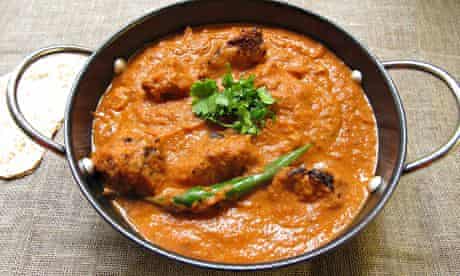Like many great dishes, the origins of chicken tikka masala (or CTM, as it's known to aficionados) is a subject of spicy debate. Ahmed Aslam Ali claims he invented the dish, which bears a strong resemblance to Punjabi butter chicken, in his Glasgow restaurant in the early 1970s after a customer complained that his chicken tikka was "a bit dry" – a story repeated by innumerable others, often embellished with the detail that the original sauce was made from tinned tomato soup.
But as credit has also been given to everyone from the last Mughal emperor, Bahadur Shah II, to Tony Blair's friend Sir Gulam Noon and Delhi street food vendors, it seems likely that we will never know who first came up with the idea of smothering tandoori chicken in a rich, tomatoey gravy. My suspicions are that chicken tikka masala is simply a British adaptation of the aforementioned murgh makhni – Alfred Prasad of the Michelin-starred Tamarind restaurant in London reckons the only significant difference between the two is the onions in the CTM, while Indian-born food blogger Michelle Peters-Jones tells me it's the cream and fenugreek leaves in butter chicken that set it apart.
I'll trust them on the specifics; whatever its pedigree, done well, chicken tikka masala is undeniably delicious. And you know what they say: if you want a job done well, do it yourself.
The chicken

Boneless chicken breast is the most popular choice for chicken tikka masala – very few recipes seem to use thigh. I'm surprised by this, as breast is rarely the most interesting choice, but the larger chunks do make for a better contrast between sauce and meat, and also remain more tender. That said, the thigh I sneak into Rick Stein's recipe stays juicier and has a more powerful chicken flavour. Both have their benefits, so I'm going to use a mixture of the two.
The chicken tikka element of this dish should, strictly speaking, be cooked in a wood- or charcoal-fired tandoor, but without, the best way to achieve that charred result is with a smoking-hot grill, as Madhur Jaffrey suggests in her Ultimate Curry Bible. Stein threads them on to skewers and cooks them on a griddle, while others bake them in a super-heated oven – all yield decent results, but the grilled meat is more evenly charred and moister than the others.
The marinade
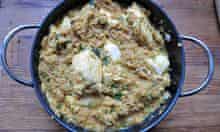
The chicken is marinated in spices for between 30 minutes (Stein's Far Eastern Odyssey) and 48 hours (Dan Toombs, AKA the Curry Guy). That marinade generally also includes a sour element, usually lemon juice, and a dairy product such as yoghurt or cream, both intended to tenderise the meat, plus copious amounts of ginger and garlic.
The spice selection is less uniform; paprika is popular for colour, accompanied, most commonly, by cumin and garam masala. On balance, I think that's all you really need at this stage: Stein's green cardamom and Toombs' fenugreek leaves don't add much to the finished result, but I am intrigued by the latter's smoked paprika. As paprika isn't traditionally used in Indian kitchens, it seems no more inauthentic than the standard variety, and its smoky flavour is a boon for cooks hoping to replicate the effects of a tandoor at home.
Half an hour doesn't prove sufficient – Stein's chicken is a bit bland – but I'm not convinced that 48 hours is worthwhile either. Overnight, with an initial half hour in the lemon juice, as Toombs, Stein and Jaffrey suggest, seems a happy medium.
The sauce
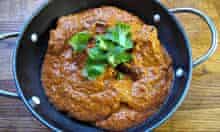
This is the most important part as far as I'm concerned; I'll usually order something else, then mop up friends' CTM sauce with my naan when they're not looking. It should be savoury with tomatoes, but with a hint of sweetness too; rich without being overtly creamy; and moderately spiced, rather than fiery.
At the base of almost every tikka masala sauce, as Prasad notes, are onion, ginger and garlic; indeed, I miss the onions in Anjum Anand's version from I Love Curry. Pureeing them, as Noon suggests in David Burnett and Helen Saberi's fascinating history of all things curried, The Road to Vindaloo, makes the sauce too pungent – simple chopping will do, especially as I will be adopting Toombs' technique of pureeing the entire thing, once cooked, for a super-silky finish.
Tomatoes lend both colour and sweet-sour flavour. Most recipes recommend the fresh sort, but at this time of year, I think this risks veering too far towards the sour end of things. Toombs' tinned versions seem safer, while Stein and Anand's dollop of tomato puree adds extra oomph. And while we're on the subject of oomph, I don't think you need Jaffrey's chicken stock; if plain old water will do for Stein, Noon and Anand, it'll do for me.
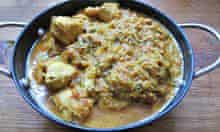
Though stirring the excess marinade into the sauce, as Stein and Toombs suggest, appeals to my thrifty side, too much of it also risks leaving the sauce too sour – and Noon and Anand's single cream makes things too thin. Jaffrey's whipping cream is a better bet; Toombs' double variety strays into sickly territory.
As with the marinade, every recipe has its own spice blend. Chilli powder is very popular, though Noon and Anand use fresh green chillies instead, which I rather like for their flash of colour. Paprika is another must for its vivid red colour Noon and Jaffrey use ground coriander and turmeric, but I'm drawn to the sweeter spices used by Anand and Toombs: cinnamon, cloves and cardamom. Though I would never have guessed they played a part in classic restaurant tikka masala sauce, Anand's flavours are almost bang on – finished with the fenugreek leaves familiar from our old friend the murgh makhni.
The pair also add a little sugar, with Anand explaining that "you will need to taste carefully as you cook, as the sweet-sour balance of tomatoes changes with the season and variety. Balance the tartness with sugar or cream, or, if it's already sweet, omit the sugar." (Stein uses ground almonds for sweetness, but, much as I love them in curries, I don't think they belong in this particular one.) It's also wise to keep some lemon juice on hand in case you go too far; chicken tikka masala should have a balance of sweet and sour flavours.
The finishing touches
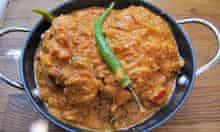
To make things really rich, you could do as Toombs suggests and finish your sauce with butter, but that's taking things too much in the makhni direction for my liking (as well as making his curry taste powerfully, and slightly queasily, of ghee). A sprinkle of garam masala and a scattering of fresh coriander leaves is all you need – plus the obligatory naan, pilau rice, saag bhaji and tarka daal, of course.
The perfect chicken tikka masala
(Serves 4)
For the chicken tikka:
4 boneless, skinless chicken thighs
2 boneless, skinless chicken breasts
Juice of 2 lemons
1 tsp salt
150ml plain yoghurt
1 tbsp pureed ginger (use a pestle and mortar)
1 tbsp crushed garlic (about 3 cloves)
1½ tsp ground cumin
1 tbsp garam masala
1 tbsp smoked sweet paprika
For the sauce:
2 tbsp ghee/clarified butter (or flavourless oil)
2 small onions, chopped
6 green cardamom pods,
1 black cardamom pod (optional)
2cm cinnamon stick
4 cloves
2 tbsp pureed ginger (use a pestle and mortar)
8 garlic cloves, crushed to a puree
400g chopped tomatoes
1 tbsp tomato puree
2 small green chillies, split
1 tsp sugar
50ml whipping cream
1 tsp paprika
½ tsp fenugreek leaves, ground
1 tsp garam masala
1 tbsp lemon juice (optional)
Small handful of coriander leaves, to serve
Cut the chicken into bite-sized chunks and stir in the lemon juice and salt. Leave to marinade for 30 minutes. Stir the remaining marinade ingredients together and add to the bowl. Stir well to coat, cover and chill overnight, then bring to room temperature before cooking.
To make the sauce, heat the ghee or other fat in a frying pan over a medium-high heat and add the onions. Fry until soft and golden brown, stirring regularly. Meanwhile, grind the seeds from the cardamom pods, the cinnamon stick and cloves to a smooth powder using a pestle and mortar.
Stir the pureed ginger and garlic into the onions and fry for a couple of minutes, stirring, then add the powdered spices and fry for a minute or so. Tip in the tomatoes and tomato puree plus 300ml water, bring to a simmer, turn the heat down to medium and cook until the oil starts to pool around the sides of the pan.
Meanwhile, heat your grill as high as it goes, and thread the chicken on to metal skewers, pushing the pieces well together. Put on a lined baking sheet as close to the grill as possible and grill for six to eight minutes on each side, until nicely charred at the edges.
Puree the sauce until smooth, then, once the chicken is done, return the pureed sauce to the pan on a medium heat. Stir any remaining marinade into the sauce, along with the chillies, sugar, cream and paprika – you can add more of the latter if necessary to give the sauce a deeper colour. Add the chicken, fenugreek and garam masala and cook for about five minutes, then taste for seasoning. Add more salt or sugar or the lemon juice if you like, then serve with chopped coriander.
CTM: beloved, spicy comfort food or shameful British abomination? How do you make yours, and which other restaurant favourites would you like to recreate at home?
